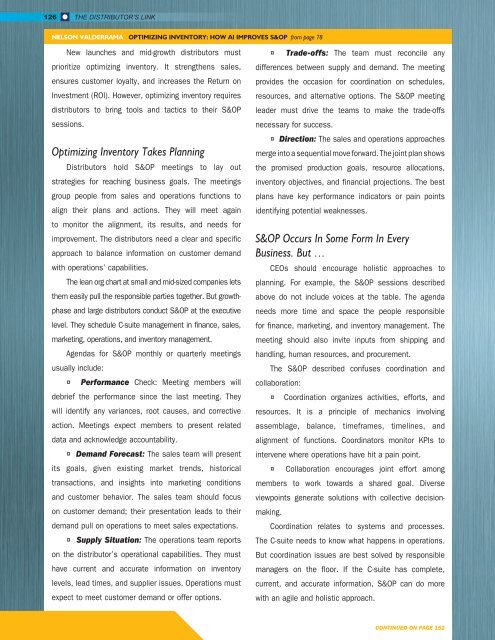SUMMER 2023
Distributor's Link Magazine Summer 2023 / Vol 46 No 3
Distributor's Link Magazine Summer 2023 / Vol 46 No 3
You also want an ePaper? Increase the reach of your titles
YUMPU automatically turns print PDFs into web optimized ePapers that Google loves.
126<br />
THE DISTRIBUTOR’S LINK<br />
NELSON VALDERRAMA OPTIMIZING INVENTORY: HOW AI IMPROVES S&OP from page 78<br />
New launches and mid-growth distributors must<br />
prioritize optimizing inventory. It strengthens sales,<br />
ensures customer loyalty, and increases the Return on<br />
Investment (ROI). However, optimizing inventory requires<br />
distributors to bring tools and tactics to their S&OP<br />
sessions.<br />
Optimizing Inventory Takes Planning<br />
Distributors hold S&OP meetings to lay out<br />
strategies for reaching business goals. The meetings<br />
group people from sales and operations functions to<br />
align their plans and actions. They will meet again<br />
to monitor the alignment, its results, and needs for<br />
improvement. The distributors need a clear and specific<br />
approach to balance information on customer demand<br />
with operations’ capabilities.<br />
The lean org chart at small and mid-sized companies lets<br />
them easily pull the responsible parties together. But growthphase<br />
and large distributors conduct S&OP at the executive<br />
level. They schedule C-suite management in finance, sales,<br />
marketing, operations, and inventory management.<br />
Agendas for S&OP monthly or quarterly meetings<br />
usually include:<br />
¤ Performance Check: Meeting members will<br />
debrief the performance since the last meeting. They<br />
will identify any variances, root causes, and corrective<br />
action. Meetings expect members to present related<br />
data and acknowledge accountability.<br />
¤ Demand Forecast: The sales team will present<br />
its goals, given existing market trends, historical<br />
transactions, and insights into marketing conditions<br />
and customer behavior. The sales team should focus<br />
on customer demand; their presentation leads to their<br />
demand pull on operations to meet sales expectations.<br />
¤ Supply Situation: The operations team reports<br />
on the distributor’s operational capabilities. They must<br />
have current and accurate information on inventory<br />
levels, lead times, and supplier issues. Operations must<br />
expect to meet customer demand or offer options.<br />
¤ Trade-offs: The team must reconcile any<br />
differences between supply and demand. The meeting<br />
provides the occasion for coordination on schedules,<br />
resources, and alternative options. The S&OP meeting<br />
leader must drive the teams to make the trade-offs<br />
necessary for success.<br />
¤ Direction: The sales and operations approaches<br />
merge into a sequential move forward. The joint plan shows<br />
the promised production goals, resource allocations,<br />
inventory objectives, and financial projections. The best<br />
plans have key performance indicators or pain points<br />
identifying potential weaknesses.<br />
S&OP Occurs In Some Form In Every<br />
Business. But …<br />
CEOs should encourage holistic approaches to<br />
planning. For example, the S&OP sessions described<br />
above do not include voices at the table. The agenda<br />
needs more time and space the people responsible<br />
for finance, marketing, and inventory management. The<br />
meeting should also invite inputs from shipping and<br />
handling, human resources, and procurement.<br />
The S&OP described confuses coordination and<br />
collaboration:<br />
¤ Coordination organizes activities, efforts, and<br />
resources. It is a principle of mechanics involving<br />
assemblage, balance, timeframes, timelines, and<br />
alignment of functions. Coordinators monitor KPIs to<br />
intervene where operations have hit a pain point.<br />
¤ Collaboration encourages joint effort among<br />
members to work towards a shared goal. Diverse<br />
viewpoints generate solutions with collective decisionmaking.<br />
Coordination relates to systems and processes.<br />
The C-suite needs to know what happens in operations.<br />
But coordination issues are best solved by responsible<br />
managers on the floor. If the C-suite has complete,<br />
current, and accurate information, S&OP can do more<br />
with an agile and holistic approach.<br />
CONTINUED ON PAGE 152
















